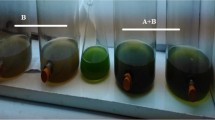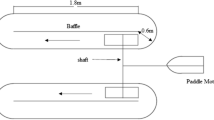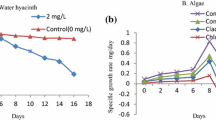Abstract
Filamentous algae biomass is very limited in aerobic constructed wetlands and totally absent in anaerobic constructed wetlands. Its contribution to the removal of sulphur from acid mine drainage will therefore rarely reach a significant level if not used in association with secondary algae treatment ponds as part of a biological hybrid treatment system. Although a high sulphur concentration has a lower environmental impact than dissolved metals and acidity, it does have an adverse impact on water quality. The current study employed selected macroalgal species under laboratory conditions to determine the bioaccumulation of sulphur (S) and other important algal growth elements such as calcium (Ca), magnesium (Mg) and phosphorus (P) from acid mine drainage (AMD) water and treated constructed wetland water at different pH values. Following exposure of the macroalgae to AMD and treated constructed wetland water for 192 h, Microspora tumidula showed the highest bioaccumulation of S and P which occurred at a pH of 5. Oedogonium crassum showed the highest bioaccumulation of Ca and Mg at a pH of 7. The results also showed that the accumulation efficiency of Mg by all three macroalgal species increased significantly as the pH increased. The filamentous species Oedogonium crassum and Klebsormidium klebsii showed very little increase in chl-a (mg g−1 fw) and ash free dry weight (mg g−1 AFDW) after exposure to the mine and treated constructed wetland water after 192 h at all four pH ranges in comparison to the species M. tumidula. However, the species M. tumidula show significant increases in both chl-a (mg g−1 fw) and mg g−1 AFDW at pH values 5, 6.14 and 7. The study established that the species M. tumidula is a good candidate for use in a biological hybrid system for treating sulphur-rich acid mine drainage.




Similar content being viewed by others
References
American Public Health Association (APHA) (1992) American Water Works Association (AWWA) and water pollution control federation (WPCF) standard methods for the examination of water and wastewater (19th ed.) APHA. In: AWWA and WPCF. USA, Washington DC
Auditor-General South Africa (AGSA) (2009) Report of the Auditor-General to Parliament on a performance audit of the rehabilitation of abandoned mines at the Department of Minerals and Energy. South Africa, Pretoria
Ayed HBA, Taidi B, Ayadi H, Pareau D, Stambouli M (2016) Magnesium uptake by the green microalga Chlorella vulgaris in batch cultures. J Microbiol Biotechnol 26:503–510
Bender J, Phillips P (1993) Implementation of microbial mats for bioremediation. In: Means JL, Hinchee RE (eds) Emerging technology for bioremediation of metals. Lewis Publishers, Boca Raton, pp 85–98
Bender J, Phillips P (2004) Microbial mats for multiple application in aquaculture and bioremediation. Bioresour Technol 94:229–238
Boshoff HP, Bergh CE, Kruszewska KJ (1991) Analyses of coal product samples of producing south African collieries. CSIR, Pretoria
Bowell RJ (2004) A review of sulphate removal options for mine water. In: Jarvis AP, Dudgeon BA, Younger PL Mine water 2004. Proceedings International Mine Water Association Symposium 2, University of Newcastle, pp 75–91
Carvalho AP, Silva SO, Baptista JM, Malcata FX (2011) Light requirements in microalgal photobioreactors: an overview of biophotonic aspects. Appl Microbiol Biotechnol 89:1275–1288
Das BK, Roy A, Koschorreck M, Mandal SM, Wendt-Potthoff K, Bhattacharya J (2009a) Occurrence and role of algae and fungi in acid mine drainage environment with special reference to metals and sulfate immobilisation. Wat Res 43:883–894
Das BK, Roy A, Singh S, Bhattacharya J (2009b) Eukaryotes in acidic mine drainage environments: potential applications in bioremediation. Rev Env Sci. Biotech 8:257–274
Davidian J, Kopriva S (2010) Regulation of sulfate uptake and assimilation—the same or not the same? Mol Plant 3:314–325
Davison IR (1991) Environmental effects on algal photosynthesis: temperature. J Phycol 27:2–8
De Klerk AR, van Wyk JH, de Klerk LP, Botha A-M (2016) A watershed approach in identifying key abiotic ecosystem drivers in support of river management: a unique case study. Water Air Soil Pollut 227:1–17
Department of Water Affairs and Forestry (DWAF) (1996a) South African Water Quality Guidelines (second edition) Vol. 1: Domestic use. Pretoria
Department of Water Affairs and Forestry (DWAF) (1996b) South African Water Quality Guidelines (first edition) Vol. 7: Aquatic ecosystems. Pretoria
Department of Minerals and Energy (DME) (2004) Operating and developing coal mines in the Republic of South Africa. Directory D2/2004. Pretoria
Encarnaçao T, Burrows HD, Pias AC, Campos MG, Kremer A (2012) Effect of N and P on the uptake of magnesium and iron and on the production of carotenoids and chlorophyll by the microalgae Nannochloropsis sp. J Agric Sci Technol A2:824–832
Finkle BJ, Appleman D (1952) The effects of magnesium concentrations on growth of Chlorella. Plant Physiol 28:652–663
Grimmler H, Weis U (1992) Dunaliella acidophila—life at pH 1.0. In: Avron M, Ben-Amotz A (eds) Dunaliella - Physiology. Biochemistry and Biotechnology. CRC Press, Boca Raton, pp 99–133
Gorain PC, Bagchi MN (2013) Effects of calcium, magnesium and sodium chloride in enhancing lipid accumulation in two green microalgae. Env Technol 34:1887–1894
Gross W (2000) Ecophysiology of algae living in highly acidic environments. Hydrobiologia 433:31–37
Johnson B (2014) Recent developments in microbiological approaches for securing mine wastes and recovering metals from mine waters. Fortschr Mineral 4:279–292
Juneja A, Ceballos RM, Murthy GS (2013) Effects of environmental factors and nutrients availability on the biochemical composition of algae for biofuels production: a review. Energies 6:4607–4638
Kadlec RH, Reddy KR (2001) Temperature effects in treatment wetlands. Wat Env Res 73:543–557
Kepler DA (1986) Manganese removal from mine drainage by artificial wetland construction. In: Proc 8th Annual National Abandoned Mine Lands Conference, Billings, Montana. 74-80
Kleinmann RLP, Hedin RS (1993) Treating mine water using passive method. J Poll Eng 25:20–33
Larned ST (1998) Nitrogen- versus phosphorus-limited growth and sources of nutrients for coral reef macroalgae. Mar Biol 132:409-421
Lawton RJ, de Nys R, Skinner S, Paul NA (2014) Isolation and identification of Oedogonium species and strains for biomass applications. PLoS One 9:e90223
Maree JP, Hlabela P, Nengovhela AJ, Geldenhuys AJ, Mbhele N, Nevhulaudzi T, Waanders FB (2004) Treatment of mine water for sulphate and metal removal using barium sulphide. Mine Wat Env 23:195–203
Munir N, Imtiaz A, Sharif N, Naz S (2015) Optimization of growth conditions of different algal strains and determination of their lipid content. J Anim Plant Sci 25:546–553
Nishikawa K, Yamakoshi Y, Uemura I (2003) Tominaga N. Ultrastructural changes in Chlamydomonas acidophila (Chlorophyta) induced by heavy metals and polyphosphate metabolism FEMS Microbiol Ecol 44:253–259
Oberholster PJ, Genthe B, Cheng P, Botha A-M (2014) The potential of selected macroalgal species for treatment of AMD at different pH ranges in temperate regions. Wat Res 60:82–92
Oberholster PJ, Hobbs P, Genthe B, Cheng P, De Klerk A, Botha A-M (2013) An ecotoxicological screening tool to prioritise acid mine drainage impacted streams for future restoration. Env Poll 176:1–10
Oberholster PJ, Botha A-M, Hill L, Strydom WF (2017) River catchment responses to anthropogenic acidification in relationship with sewage effluent: an ecotoxicology screening application. Chemosphere 189:407–417
O'Halloran K, Cavanagh J-O, Harding JS (2008) Response of a New Zealand mayfly (Deleatidium spp.) to acid mine drainage: Implications for mine remediation. Env Tox Chem 27:1135-1140
Parent L, Campbell PGC (1994) Aluminium bioavailability to green alga Chlorella pyrenoidosa in acidified synthetic soft water. Env Tox Chem 13:587–598
Prevost MX (1997) Operating and developing coal mines in the Republic of South Africa, 1996. Department of Mineral and Energy Affairs, D2/97
Porra RJ, Thompson WA, Kriedemann PE (1989) Determination of accurate extinction coefficient and simultaneous equations for assaying chlorophylls a and b extracted with four different solvents: verification of the concentration of chlorophyll standards by atomic absorption spectrometry. Biochim Biophys Acta 975:384–394
Rees SB, Bowell RJ (1999) Stable isotopic modelling of the longevity of treatment processes operating in a constructed wetland for the amelioration of acid mine drainage. In: IMWA 20th Mine Water Conference, Seville, September 1999, 585-590
Regel RH, Ferris JM, Ganf GG, Brookes JD (2002) Algal esterase activity as a biomeasure of environmental degradation in a freshwater creek. Aquat Toxicol 59:209-223
Remis D, Treffiny B, Gimmler H (1994) Light-induced H+ transport across the plasma membrane of the acid resistant green alga Dunaliella acidophila. Plant Physiol Biochem 32:75–84
Roberts DA, Paul NA, Bird MI, de Nys R (2015) Bioremediation for coal-fired power stations using macroalgae. J Environ Manag 153:25–32
Roberts DA, de Nys R, Paul NA (2013) The effect of CO2 on algal growth in industrial waste water for bioenergy and bioremediation application. PLoS One 8(11):e81631
Schabhüttl S, Hingsamer P, Weigelhofer G, Hein T, Weigert A, Striebel M (2013) Temperature and species richness effects in phytoplankton communities. Oecologia 171:527–536
Schmidt A (1986) Regulation of sulfur metabolism in plants. Prog Bot 48:133–150
Sheoran AS, Sheoran V (2006) Heavy metal removal mechanism of acid mine drainage in wetlands: a critical review. Min Eng 19:105–116
Sheoran AS (2004) Treatment of acid mine drainage by constructed wetlands: an ecological engineering approach. In: PhD thesis
Sheoran AS, Bhandari S (2005) Treatment of mine water by a microbial mat: bench scale experiments. Mine Wat Env 24:38–42
Silva R, Cadorin L, Rubio J (2010) Sulphate ions removal from an aqueous solution: I. Co-precipitation with hydrolysed aluminium-bearing salts. Min Eng 23:1220–1226
Singh HV, Chaudhary BR (1988) Effects of certain environmental factors on the formation og oogonium in Oedogonium hatei Kam. Proc. Indian Nat Sci Acad B54:425–428
Soto P, Gaete H, Hidalgo M (2011) Assessment of catalase activity, lipid peroxidation, chlorophyll-a and growth rate in the freshwater green algae Pseudokirchneriella subcapitata exposed to copper and zinc. Latin Amer J Aquat Res 39:280–285
Steinman AD, Lamberti GA (1996) Biomass and pigments of benthic algae. In: Hauer FR and Lamberti GA (eds). Methods in stream ecology. Academic press, San Diego, pp357–379
Wildeman T, Cevall J, Whiting K, Gusek J, Scheuering J (1994) Laboratory and pilot scale studies on the treatment of acid rock drainage at a closed gold-mining operation in California. In: Proceedings of the International Land Reclamation and Mine Drainage Conference and III International Conference on Abatement of Acidic Drainage, USBM Pub. SP 06A-94, pp 379–386
Acknowledgements
The authors express their gratitude to the CSIR for funding the project as well as to colleagues for helping with the water and algae sampling. The authors also thank the unknown referees for their critical review of and constructive suggestions toward improving the manuscript.
Author information
Authors and Affiliations
Corresponding author
Rights and permissions
About this article
Cite this article
Oberholster, P.J., Cheng, PH., Botha, AM. et al. Assessment of selected macroalgae for use in a biological hybrid system for treating sulphur in acid mine drainage (AMD). J Appl Phycol 30, 1361–1370 (2018). https://doi.org/10.1007/s10811-017-1314-0
Received:
Revised:
Accepted:
Published:
Issue Date:
DOI: https://doi.org/10.1007/s10811-017-1314-0




